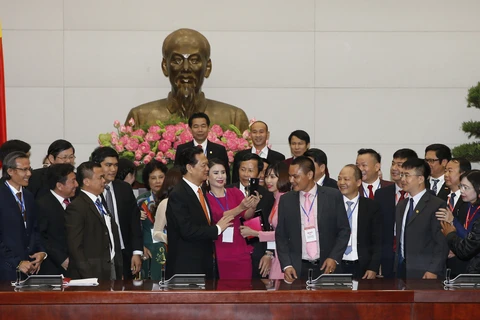Hanoi (VNA) – Having a deep comprehension of the ASEAN Economic Community (AEC) will help Vietnamese businesses grab opportunities, integrate effectively, and gain initiative in the regional and global playgrounds, heard a forum in Hanoi on December 13.
The business community is yet knowledgeable about the market or fully aware of the significant role of the AEC – which is set to take shape later this year, experts said.
Deputy Director of the Central Institute for Economic Management (CIEM) Vo Tri Thanh said ASEAN is regarded as an Asian centre of connectivity in the global value chains.
Understanding ASEAN thoroughly and making right moves could enable businesses to reap a lot of benefits from the AEC participation, Thanh noted.
Meanwhile, chairman of the Vietnam Chamber of Commerce and Industry (VCCI) Vu Tien Loc warned that the formation of the AEC will pose numerous challenges such as highly-competitive goods and services, development gaps, labour supply, and capital flow management.
Local firms should, therefore, be well prepared to deal with these challenges while making the best use of opportunities to be brought in by the community, like training prorammes and business support policies and plans developed by global organisations, he suggested.
According to Tran Thanh Hai, Deputy Head of the Department of Import-Export of the Ministry of Industry and Trade, the Government paved the way for businesses to make inroads by signing a score of bilateral and multilateral free trade agreements, along with making business-related procedures more transparent.
The Government’s follow-up guidance will be significant so businesses can be adaptable and quick to learn as their regional peers and increase their competitive edge, he stressed.
The creation of the AEC as part of the three key pillars of the ASEAN Community aims to develop a stable, prosperous, highly competitive economic association. The other two key pillars are the Political-Security Community and the Socio-Cultural Community.
The AEC itself was built with four pillars: a single market and production base, a competitive economic region, equitable economic development and integration with the global economy. A scorecard was formulated to track the members’ progress implementing the plans for the AEC.
ASEAN member states could enjoy a number of benefits following the establishment of the AEC such as rapid economic growth, more jobs, stronger foreign direct investment attraction, better resource allocation, and sharper production capacity and competitiveness.
The bloc’s leaders set an ambitious goal of developing ASEAN into a single market and production base characterised by a free flow of goods, services and investments, as well as free flow of capital and skilled labour.-VNA


























